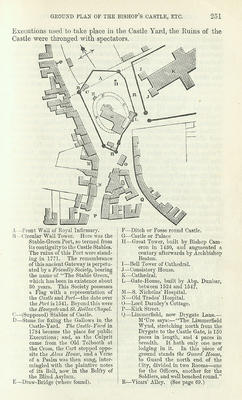
A plan of the Bishop's Castle and surrounding area at the top of the Castle Street. It was printed in Glasghu Facies, a compendium of articles about Glasgow's history that was edited by J F S Gordon and published in 1872.
A wooden booth was erected against the ruined walls of the Castle in the mid-18th century and served as Glasgow's first post-Reformation theatre. According to legend it was torn down in 1753 by a mob whipped to a frenzy of anti-theatrical zeal by the fiery Methodist preacher George Whitefield, but historians such as Adam McNaughtan have demonstrated that the story is untrue. Glasgow's public executions were carried out in the old castle yard during the 1780s, when the hangman lived in a lean-to attached to Provand's Lordship on the west side of Castle Street.
It is said that explosives were required to demolish the ruins of the formidable Great Tower at the south end of the castle site.
Reference: Mitchell Library, GC 941.435 GOR
Reproduced with the permission of Glasgow City Council, Libraries Information and Learning
Keywords:
Alms House, Bishop's Castle, Bishop's Palace, castles, city gates, executions, gallows, gatehouses, Glasgow Cathedral, Glasgow Royal Infirmary, Great Tower, Lord Darnley's Cottage, maps, Old Trades' Hospital, plans, St Nicholas' Hospital, Stable Green Port, Stables, towers
You have 0 images in your photo album.